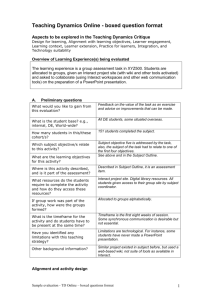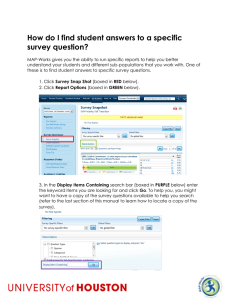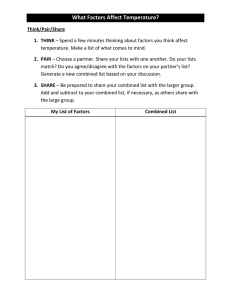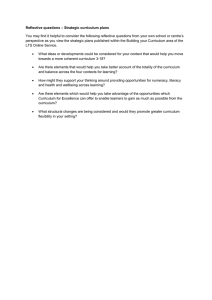Boxed question format
advertisement
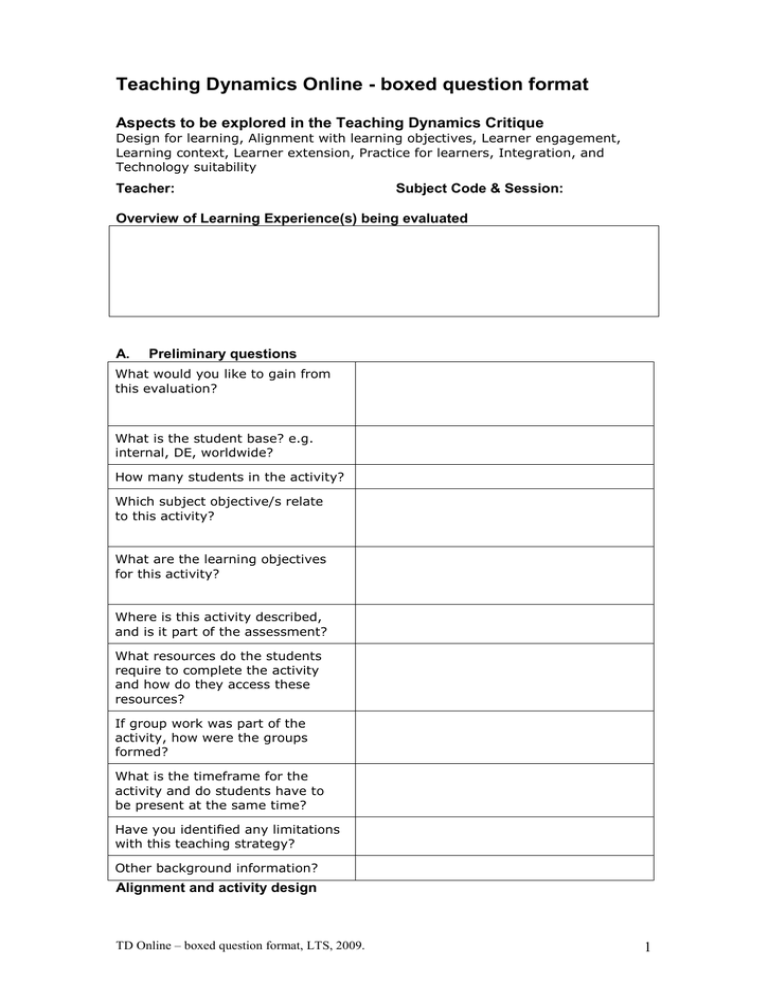
Teaching Dynamics Online - boxed question format Aspects to be explored in the Teaching Dynamics Critique Design for learning, Alignment with learning objectives, Learner engagement, Learning context, Learner extension, Practice for learners, Integration, and Technology suitability Teacher: Subject Code & Session: Overview of Learning Experience(s) being evaluated A. Preliminary questions What would you like to gain from this evaluation? What is the student base? e.g. internal, DE, worldwide? How many students in the activity? Which subject objective/s relate to this activity? What are the learning objectives for this activity? Where is this activity described, and is it part of the assessment? What resources do the students require to complete the activity and how do they access these resources? If group work was part of the activity, how were the groups formed? What is the timeframe for the activity and do students have to be present at the same time? Have you identified any limitations with this teaching strategy? Other background information? Alignment and activity design TD Online – boxed question format, LTS, 2009. 1 Item Agree Uncertain Disagree The task/s requirements are clearly expressed The task/activity enables the achievement of the specified learning objective/s There are features to encourage student participation or active learning There are strategies are in place to ensure that all students are participating There are feedback mechanisms are in place to support student learning The activity is designed to facilitate interactivity This activity and its resources align with assessment tasks and objectives Comments on the design of the activity and its alignment to the learning objectives Recommended enhancements to the design of the activity TD Online – boxed question format, LTS, 2009. 2 Learner Engagement Item Agree Uncertain Disagree N/A The design of the activity provides opportunities for learners to develop connections and rapport with other learners and with the lecturer The design of the activity takes into account the learners’ prior experiences and understandings with regard to content, language, terminology, type of task, technology-used, etc The design of the activity enables students to experience the concepts/ideas/issues of the subject in a variety of different ways The design of the activity allows for range of opportunities peer interaction and feedback The activity supports and enables learners to draw from and reflect upon their experience The design of the activity engages students affectively i.e. with regard to feelings and emotions The activity gives learners a sense of control over their engagement with the activities Comments on how learner engagement is supported by the design of the activity Recommended enhancements to the design of the activity TD Online – boxed question format, LTS, 2009. 3 Learning context Item Agree Uncertain Disagree N/A The activity is based on real life problems or authentic tasks This activity encourages students to build connections between theory and practice The activity is appropriately embedded within the subject design Comments on the context and nature of the activity Recommended enhancements to the design of the activity Learner extension (Challenge) Item Agree Uncertain Disagree N/A The activity questions the student’s knowledge base and highlights any gaps The activity provides opportunities for the student to extend and build their knowledge as well as higher order thinking skills Comments on how the students learning is extended Recommended enhancements to the design of the activity TD Online – boxed question format, LTS, 2009. 4 Practice for learners Agree Item Uncertain Disagree N/A The activity encourages demonstration of student skill/knowledge Feedback (lecturer and/or peer) is provided to the student progressively at key points The activity encourages learner practice Comments on how the activity facilitates and/or demonstrates practice for learners Recommended enhancements to the design of the activity Integration Agree Item Uncertain Disagree N/A The activity relates and/or links with other activities and/or resources The connection is made apparent The activity relates to the assessment Comments on aspects of the integration of the activity Recommended enhancements to the design of the activity TD Online – boxed question format, LTS, 2009. 5 Technology suitability Agree Item Uncertain Disagree N/A The tool or combination of tools facilitates and supports the activity The technology chosen requires special skills If so is student support provided? The environment and its resources download without lengthy delays (short activity – 2 min max, major activity 5 min max) The environment, its resources and the activity accessible and available to all students enrolled in the subject (bandwidth reqd, time zone, permissions, time, access for impaired) Comments on the suitability of the technology selected Recommendations TD Online – boxed question format, LTS, 2009. 6 Summary report Comments and recommendations Teacher comments How was the student experience? What was achieved through the activity? What would you do differently next time? Would you be interested in creating an Interact Exemplar or Learning Design to share with other academics at CSU? Yes O No O Maybe later O Signature/s: _____________________________________ Date: ____________ TD Online – boxed question format, LTS, 2009. 7 Evaluation instrument based primarily on: Agostinho, S, Oliver, R., Harper, B., Hedberg, H., & Wills, S. (2002). A tool to evaluate the potential for an ICT-based learning design to foster "high-quality learning". In A. Williamson, C. Gunn, A. Young., & T. Clear (Eds.), Winds of change in the sea of learning. Proceedings of the 19th Annual Conference of the Australasian Society for Computers in Learning in Tertiary Education. Auckland, New Zealand: UNITEC Institute of Technology. pp. 29-38. Herrington, T., Herrington, J., Oliver, R., Stoney, S. & Willis, J. (2001). An ECU framework for assessing quality of on-line learning materials, Edith Cowan University. Retrieved from http://www.ecu.edu.au/CLT/docs/quality_online_wg.doc Reeves. T. (Presenter). (2008). Eight Dimensions of Effective eLearning Environments [Podcast lecture]. Wollongong University. Retrieved April 4, 2008, from http://www.uow.edu.au TD Online – boxed question format, LTS, 2009. 8
